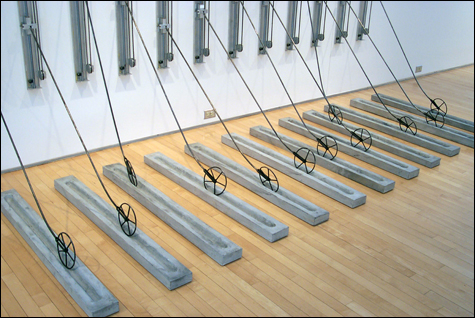
FASCINATINGLY INSCRUTABLE: Alison Safford’s Futility Toy [2007]. |
In Wade Kramm’s 2006 sculpture Janus (Self Portrait), a plaster blob resembling a ridged vase sits atop a pedestal. A spotlight focused on it casts a shadow onto the wall that resembles the two-faced head of the Roman god Janus. And then it dawns on you that the plaster thing is slowly, slowly rotating and as it turns the mouths of the two shadow faces slowly open and close. Kramm, who lives in Pawtucket, specializes in these kind of surprises.
He and Alison Safford of Jamaica Plain, Massachusetts, are featured in the exhibit “Purpose Considered” at Bristol Community College’s Grimshaw-Gudewicz Art Gallery.
Kramm’s Soap Bar Worn from the Inside Out (2006) is 10 photographs of a rectangle of soap that develops a hole, like a wound, slowly wearing away, until it resembles a tiny frame made of bone. His Unconscious Variations of a Rectangular Form (My Pillow Cast Each Morning for a Week) (2000) is seven plaster-cast pillows, all twisted and folded, arranged in a row along the middle of the gallery floor. The sculptures are public, permanent monuments to the intimate, vulnerable, ephemeral moment of waking. The title shows that Kramm is after a kinder, gentler version of 1960s minimalist art — an art that shares vintage minimalism’s concern with simple forms and repetition, but sweetened by conceptual jokes and games.
Still Life (Pears) (2006) features flat cut-out wooden shapes jutting out perpendicular to a framed wood board. A spotlight shines on the cut-outs from below, projecting shadows resembling four pears onto the board. It’s a neat-o trick that upends normal reality: intangible shadows depict the fruit and solid wood cut-outs represent shadows.
Kramm’s work is built on subtle observations that come from stepping back and contemplating everyday life — the shape of your rumpled pillow in the morning, the form soap takes as it’s used up, the tricks of shadows. He reframes them as puzzles. You find surprises as you figure them out that make such quotidian things seem more magical. But sometimes his perceptual-conceptual games feel too cute. Instead of opening up onto new thoughts, they deadend at punchlines.
At first Sundial (2003) struck me as a one-liner, but the more I thought about it, the more it seemed to suggest the potential of Kramm’s aesthetic explorations. Here he arranges 11 old found photos of standing people — a soldier, a proudly smiling boy, a flapper lady — so that you notice their shadows turning around them like the hand of a clock. (It makes me want to see his Janus turned into a stone monument in a park with its shadow animated by the rising and setting of the sun.)
Lurking in here are thoughts about photos as records of reflected light, about light coming from the sun, about shadows representing the rotation of the earth, and so days, weeks, lives. All this speaks of an elemental idea that this little gimmicky work can’t quite hold — that art equals the motion of light multiplied by time or, to put it another way, art is a memory of looking.
Alison Safford’s Pockets (for St. J. of N.) (2007) is a series of seven small white plaster cubes stuck to the gallery wall at varying heights. Each one has a hollow, painted silver, in the shape of a cast human tongue. I read it as sensual — a mysterious meditation on taste and touch and sex.
But when I call Safford, she tells me she’s actually referencing St. John of Nepomuk, a 14th-century Roman Catholic saint venerated in Prague. Safford’s interest derives from the version of the saint’s biography in which the local king and queen made their confessions to John, but when the king demanded that John tell him what the queen said, John refused. So the king had him tortured and thrown off a Prague bridge to drown. He was quickly declared a martyr. And when his remains were dug up in the 18th century, they say they found his tongue pretty well preserved — a reminder of his saintly refusal to divulge the queen’s confession. For Safford, the tongues symbolize secrets shared and kept. The subject has potential, but the religious reference is obscure, and the sculpture’s form doesn’t lead you there.
Sometimes her forms are cheesy, as in two series of bronze things bursting from cast-metal mouths. Better is Futility Toy (2007), a dozen machines mounted to the gallery wall that piston up and down, sliding frail metal arms, with wheels on the ends, back and forth in gray plaster troughs lined up on the floor. A motion detector mounted on a box on the floor seems to set the thing in jerky motion. So it’s movements are driven by your wanderings in the gallery. Its elaborate, determined purposelessness (a metaphor for art?) is fascinatingly inscrutable.